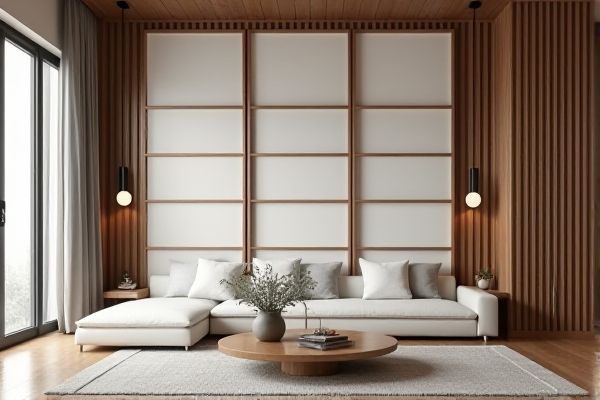
Room dividers create distinct zones within your living space, offering privacy and style without permanent construction, while folding screens provide a flexible, portable solution that can be easily moved or stored when not in use. Explore the rest of the article to discover which option best suits your needs and enhances your home's design.
Table of Comparison
| Feature | Room Divider | Folding Screen |
|---|---|---|
| Purpose | Permanent or semi-permanent space separation | Portable, temporary space partitioning |
| Material | Wood, glass, metal, fabric panels | Wood frame, fabric, paper, or woven material |
| Design | Fixed or sliding panels, bulkier structure | Multiple hinged panels, foldable and lightweight |
| Installation | May require mounting or assembly | No installation needed, easy to move |
| Use Case | Defining rooms, offices, permanent zones | Privacy screens, decorative accent, flexible use |
| Space Efficiency | Can occupy more floor space | Foldable, saves space when not in use |
| Price Range | Moderate to high, depends on materials and size | Low to moderate, generally affordable |
| Mobility | Limited mobility, often fixed | Highly portable and adjustable |
Introduction to Room Dividers and Folding Screens
Room dividers and folding screens serve as versatile solutions for creating privacy and defining spaces within a room. Room dividers are often larger, stationary pieces designed to section off areas permanently or semi-permanently, while folding screens offer portability and flexibility with their hinged panels. Choosing the right option depends on Your need for either fixed separation or adaptable spatial design.
Key Differences Between Room Dividers and Folding Screens
Room dividers are typically larger, fixed or semi-permanent structures designed to partition space effectively, while folding screens are portable, lightweight panels that can be easily moved and stored. Room dividers often provide sound insulation and privacy, making them suitable for permanent separation, whereas folding screens focus on flexibility and decorative appeal. Understanding these key differences helps you select the best option based on your space, functionality, and style needs.
Types and Materials of Room Dividers
Room dividers come in various types including freestanding panels, sliding doors, and bookcase partitions, each offering distinct space-saving benefits. Materials range from wood, bamboo, and metal to fabric and glass, allowing customization to match your interior style and functional needs. Folding screens, a popular subtype, typically feature lightweight wooden or metal frames with fabric or paper panels for easy mobility and aesthetic appeal.
Types and Materials of Folding Screens
Folding screens come in various types such as shoji, leather panel, and decorative fabric screens, each offering distinct aesthetic and functional qualities. Common materials include rice paper for a traditional Japanese look, wood or bamboo frames for durability and natural appeal, and fabric or vinyl for lightweight, portable options. These materials influence the screen's opacity, style, and ease of maintenance, making folding screens versatile choices for room division compared to fixed room dividers.
Space-Saving Benefits Compared
Room dividers create permanent or semi-permanent separations that maximize vertical space usage without frequent repositioning, ideal for defining areas in open-plan layouts. Folding screens offer flexible, portable solutions that can be easily collapsed and stored, delivering adaptable space-saving benefits for temporary or changing needs. Your choice depends on whether you prioritize fixed spatial division or versatile, movable partitioning to optimize room functionality.
Aesthetic and Style Considerations
Room dividers often offer a solid, modern aesthetic that complements minimalist or industrial interiors, providing a sleek and functional way to define spaces. Folding screens bring a traditional, artistic touch with intricate patterns, vibrant colors, or fabric panels, enhancing bohemian or vintage-inspired decor. Choosing between the two depends on desired visual impact, with room dividers emphasizing clean lines and folding screens delivering decorative elegance.
Privacy and Functionality Comparison
Room dividers provide more stable and permanent privacy solutions, often constructed from solid materials that block sound and sight effectively. Folding screens offer flexible, portable privacy options with lightweight panels that can be easily moved or stored, although they typically provide less sound insulation. Functionality-wise, room dividers serve as fixed partitions ideal for defining spaces long-term, while folding screens excel in versatility and decorative appeal for temporary or changing layouts.
Durability and Maintenance Factors
Room dividers typically offer greater durability due to their solid construction with sturdy materials such as wood, metal, or glass, making them a long-lasting choice for defining spaces. Folding screens often feature lightweight frames and fabric or paper panels, which require more delicate handling and regular maintenance to prevent wear and tear. Your selection should consider the balance between durability and ease of cleaning, especially if the divider will be moved frequently or exposed to high-traffic environments.
Cost and Budget Implications
Room dividers typically involve a higher initial investment due to fixed installation costs and durable materials, while folding screens offer a more budget-friendly, portable option with lower upfront expenses. Folding screens require minimal setup and can be easily moved or stored, reducing potential renovation costs often associated with permanent room dividers. Cost considerations should account for material quality, intended use duration, and whether flexibility or permanence is prioritized.
Which One to Choose: Room Divider or Folding Screen?
Choosing between a room divider and folding screen depends on your space and style needs; room dividers are typically more permanent and provide sturdy separation, while folding screens offer flexibility and easy mobility. Consider your room's size, decor, and how often you need to reconfigure the layout to decide which option suits your living area best. Your choice will impact both the functionality and aesthetics of your space.
 homyna.com
homyna.com